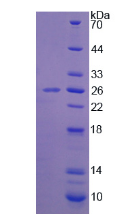Active Superoxide Dismutase 3, Extracellular (SOD3)
SOD-3; EC-SOD; Extracellular Superoxide Dismutase Cu-Zn
- Product No.APA117Mu01
- Organism SpeciesMus musculus (Mouse) Same name, Different species.
- Buffer Formulation20mM Tris, 150mM NaCl, pH8.0, containing 1mM EDTA, 1mM DTT, 0.01% SKL, 5% Trehalose and Proclin300.
- Traits Freeze-dried powder
- Purity> 90%
- Isoelectric Point6.8
- ApplicationsCell culture; Activity Assays.
- DownloadInstruction Manual
- UOM 10µg50µg 200µg 1mg 5mg
- FOB
US$ 266
US$ 664
US$ 1328
US$ 3984
US$ 9960
For more details, please contact local distributors!
ACTIVITY TEST

Extracellular superoxide dismutase [Cu-Zn] is an enzyme that in humans is encoded by the SOD3 gene. This gene encodes a member of the superoxide dismutase (SOD) protein family. SODs are antioxidant enzymes that catalyze the dismutation of two superoxide radicals into hydrogen peroxide and oxygen. According to the report, in a weakly alkaline buffer solution (pH=8.2) with N-tris (hydroxymethyl) amino methane-HCL, pyrogallol can occur autoxidation in the air, then SOD can inhibit this reaction. Thus, we use this way to measure the activity of recombinant mouse SOD3. The reaction was performed in adding 30μL 50mmol/L pyrogallol to 900μL 50mmol/L Tris-HCl in 1.5mL cuvette (1.0cm light path), rapidly mixing at 25℃,then read at 325nm (zero the spectrophotometer using 50mmol/L Tris-HCl), record the OD value every 30 second for 6 times. Control the pyrogallol autoxidation rate at 0.70 OD/min. After, adding various concentrations of recombinant of SOD3 to 900μL 50mmol/L Tris-HCl, incubated for 20min at 25℃, then adding 30μL 50mmol/L pyrogallol to each tube, rapidly mixing and read at 325nm, record the OD value every 30 second for 6 times. Under these conditions, the enzyme amount of 50% per minute inhibition of pyrogallol autooxidation is defined as a unit.
USAGE
Reconstitute in 20mM Tris, 150mM NaCl (pH8.0) to a concentration of 0.1-1.0 mg/mL. Do not vortex.
STORAGE
Avoid repeated freeze/thaw cycles. Store at 2-8°C for one month. Aliquot and store at -80°C for 12 months.
STABILITY
The thermal stability is described by the loss rate. The loss rate was determined by accelerated thermal degradation test, that is, incubate the protein at 37°C for 48h, and no obvious degradation and precipitation were observed. The loss rate is less than 5% within the expiration date under appropriate storage condition.
GIVEAWAYS
INCREMENT SERVICES
-
 BCA Protein Quantification Kit
BCA Protein Quantification Kit
-
 Molecular Mass Marker for Protein
Molecular Mass Marker for Protein
-
 Monoclonal Antibody Customized Service
Monoclonal Antibody Customized Service
-
 Polyclonal Antibody Customized Service
Polyclonal Antibody Customized Service
-
 Protein Activity Test Experiment Service
Protein Activity Test Experiment Service
-
 Electrophoretic Mobility Shift Assay (EMSA) Experiment Service
Electrophoretic Mobility Shift Assay (EMSA) Experiment Service
-
 Buffer
Buffer
-
 Lentivirus Packaging Experiment Service
Lentivirus Packaging Experiment Service
-
 Adenovirus Packaging Experiment Service
Adenovirus Packaging Experiment Service
-
 Real Time PCR Experimental Service
Real Time PCR Experimental Service
-
 Spike RBD Protein (S-RBD)
Spike RBD Protein (S-RBD)
-
 Protein G
Protein G
-
 Protein A
Protein A
| Magazine | Citations |
| Current Alzheimer Research | Comparison of Extracellular and Intracellular Blood Compartments Highlights Redox Alterations in Alzheimer's and Mild Cognitive Impairment Patients. pubmed:27748187 |
| Frontiers in Microbiology | Burn Serum Increases Staphylococcus aureus Biofilm Formation via Oxidative Stress. pubmed:28702016 |
| Nature Communications | SOD3 improves the tumor response to chemotherapy by stabilizing endothelial HIF-2α Pubmed:29422508 |
| BMC Neuroscience | Neuroprotective dobutamine treatment upregulates superoxide dismutase 3, anti-oxidant and survival genes and attenuates genes mediating inflammation Pubmed:29523072 |
| Diabetes-Metabolism Research and Reviews | Myeloperoxidase, superoxide dismutase‐3, cardiometabolic risk factors, and distal sensorimotor polyneuropathy: The KORA F4/FF4 study Pubmed:29577557 |
| Advances in Medical Sciences | Selected elements of extracellular matrix of the skin in diabetes and insulin resistance Pubmed: 31146169 |
| Clinical Kidney Journal | Serum uromodulin is inversely associated with biomarkers of subclinical inflammation in the population-based KORA F4 study |
| PLoS One | Association of circulating MR-proADM with all-cause and cardiovascular mortality in the general population: Results from the KORA F4 cohort study Pubmed:34990470 |
| ORIGINAL RESEARCH PATHOPHYSIOLOGY | EFFECTS OF HIS-PHE-ARG-TRP-PRO-GLY-PRO PEPTIDE ON FREE-RADICAL OXIDATION PROCESSES IN CONDITIONS OF CHRONIC RESTRAINT … |









